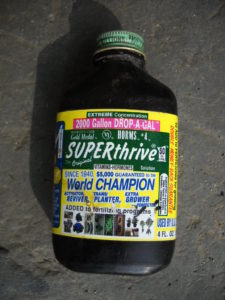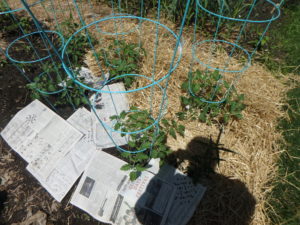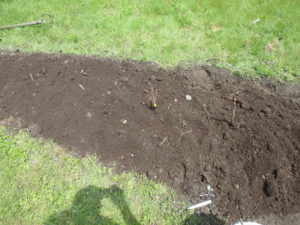7 Things to Do to Improve Your Garden – and Your Life!
If you’re like me, by now you have your garden planted, both vegetables and flowers. It seems like a good time to take a deep breath, pour a cold glass of your favorite beverage and watch the flowers perform. I have set up chairs by my Japanese primroses for viewing, and have invited friends to come see them and relax. But wait! There is still a lot to do, and you can make your life easier with some work now. Here are 7 garden activities I recommend.
- Weeds in the vegetable garden are little now, and easy to pull. Take 20 minutes a day – or twice a day – and just weed. All my weed-free beds are sprouting weeds, but the roots are small. It’s important to loosen the soil a little before pulling weeds. If you don’t do that and you hear a snap, you have broken a root. I like a CobraHead weeder for loosening the soil because it has a single tine, and is very precise.
If you are weeding in a bed with small seedlings – lettuce, for example – you may end up pulling up seedlings, too. Re-plant immediately, and water. I use an anti-stress liquid called Super Thrive, just a quarter teaspoon in a gallon of water, after weeding. It helps plants recover from having their roots disturbed. It has plant hormones and seaweed extracts, and I find it very effective.
- I like to mulch after weeding, and after the soil is nice and warm. If the soil is still cool and wet, wait for a few days of hot sun before mulching. Roots like to be warm.
My preferred method of mulching is to put down several layers of newspapers around big plants like tomatoes, and in walkways. Then I cover it with straw, leaves I saved last fall, or even mulch hay. Mulch hay has seeds, but the newspaper keeps the seeds out of the soil pretty well. Leaves are the best, but always in short supply.
- Protect your tomatoes. Put tomato cages around them. They need to be kept upright, but will flop if you don’t support them. Get the 54-inch cages with 4 legs, not 3 legs. Tomato diseases are generally soil borne, so mulch the soil with grass clippings, leaves or straw to prevent splash-up.
This year I am trying an experiment with a biological control for blight on tomatoes. There is a bacterium, Bacterium subtilis, that feeds on fungi. It is now available as a commercial spray called Serenade. I have sprayed half my tomato plants with Serenade and marked them with labels. According to the directions, I will need to spray once a week. I will report back if I see a marked difference.
- Find and utilize unused spaces, both in the vegetable garden and flower beds. If you planted a few nice perennials this year, you probably left space for them when they get big. Instead of depending on mulch to fill the space, plant some annuals.
The same works in the vegetable garden: Tomato plants won’t be big for another 4 to 6 weeks. Grow lettuce around them, and eat the lettuce before they get shaded out. Spinach and radishes are good candidates for those spaces, too.
- Think about cutting off branches of trees that are now shading out your gardens. Or remove trees altogether. I love my trees, but find they are interfering with my flowers and veggies that like full sun. I removed several large branches from a pear tree this winter because it was shading my peonies. You can do that now, too.
Weed trees like box elder and poplars should be the first to be removed. They pop up and get big before you know it. Elms will grow for 25 years or so, then die from Dutch elm disease, so I cut or yank those any time I find them on the property.
- Thin root crops like carrots, beets, rutabagas and parsnips. By the Fourth of July all those should be 1 to 2 inches apart. Carrots will compete with their brothers and sisters just like they do with weeds – and suffer.
- I don’t want to sound like Anne Landers, but get a gardening partner to help in the garden. It works for me! My life partner and sweetie, Cindy Heath, has lived 6 miles away for the past 10 years. But now she has moved in so we garden together here, instead of having 2 gardens.
If you already have a husband or wife, some re-training may be needed. Pavlov had it right: Make brownies or give back rubs as a reward for help in the garden. Soon there will be no more weeds!
Henry lives and gardens in Cornish Flat, NH. He is the author of 4 gardening books.





